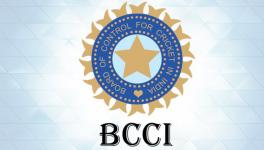India’s T20 World Cup Setback: Is Foreign Coach One of the Answers?
Image Courtesy: Twitter
At the customary captains’ group photo session before the ICC T20 World Cup started, India captain Rohit Sharma got a seat farthest from the trophy while Babar Azam and Jos Buttler, skippers of Pakistan and England, were seated closest to it. Who knew at the time that Babar and Buttler would go on to lead their teams into the final, while the title would remain elusive for India.
England blanked India by 10 wickets in the semi-finals. The defeat also meant that India have not won a global title -- i.e. either World Cup, Champions Trophy, or the World Test Championship – in nine years. Since 2013, when they won the 50-over Champions Trophy, they have lost seven times, either in the semi-finals or the finals of these competitions. These included three finals.
Peeved at this inconsistency, some people, including Kapil Dev, have started calling India ‘chokers’, a tag that is historically associated with South Africa. This has emanated from a massive disappointment for Indian fans who had lofty expectations from the team. So, are India really the new South Africa? Irrespective of the big disadvantage that half of the players in the Indian squad were playing in Australia for the first time, it would be rather too harsh to tag them ‘chokers’ right away. But it wouldn’t be harsh to say some hard decisions are the need of the hour to rebuild the team.
Having several players who hadn’t travelled Down Under earlier, however, doesn’t qualify as an excuse for India’s failure to win the
title. There were several experienced players like captain Rohit Sharma, who was part of India’s triumphant team of the maiden T20 World Cup in 2007, K L Rahul, Virat Kohli, R. Ashwin, Mohammed Shami, and Bhuvaneshwar Kumar in the XI that lost the semi-final to England. But somehow India failed to raise their game – perhaps the enormity of the occasion made the players nervous, like some seniors at the 2003 World Cup final – while England played real fearless cricket.
Fearless cricket, really?
Virender Sehwag said that India didn’t play “fearless cricket” in the semi-finals. For some time, everyone in the Indian camp has been saying that the national team now plays boldly. They may be playing better cricket in bilateral series, but in multi-team global
competitions, India often fail to replicate the passion, zeal, and ruthlessness. That shortcoming was amply visible in the semi-final
defeat, and it had been seen several times earlier, too.
In the 2003 World Cup final, for instance, India shockingly chose to bowl on winning the toss, a decision that continues to be debated. Then, the leading Indian bowlers got famously nervous, overawed by the occasion, against a marauding Aussie captain Ricky Ponting, who scored a match-winning century, and other batsmen went berserk. Players getting nervous in big matches have let the Indian team down on several crucial occasions.
Mental aspect
Steps need to be taken to address the issue of players getting nervous on big occasions. The present Indian team has a mental conditioning coach in Paddy Upton. However, some more thought and action needs to be put in this crucial area, if that helps players, especially after what happened to some cricketers due to living in bio-bubbles in the recent past. It would not be a bad idea perhaps to hire an additional psychologist, who would work with shortlisted players and prepare them
for national duty while Upton travels with the team.
In 2006, Indian team coach Greg Chappell got legendary sports psychologist Rudy Webster to work with the players briefly and some of them admitted to benefiting from the interactions with him. In the late 1970s, Chappell himself had benefited as a player by working with Webster. Had Chappell stayed on for a longer period, he might have inculcated the Aussie ruthlessness in Indian cricketers that would have benefited them.
Foreign coach the answer?
Australians naturally play aggressively, and an Aussie brings the same attributes to coaching. Pakistan is a prime example. Former Australian batsman Matthew Hayden as coach and ex-speedster Shaun Tait as fast bowling coach, within a short time with Babar Azam’s boys, guided them into the T20 World Cup final. They must have done something good with the players that has enabled Pakistan to comeback from the brink, like in the 1992 World Cup. That Pakistan lost to England in the final is a different story.
So, should India, too, go for an Aussie coach now, once Rahul Dravid’s tenure ends, or if the former captain excuses himself voluntarily? That question is not entirely invalid, especially when one looks at India’s track record of not having won a global title in nine years. Kohli the captain was unfairly targeted for not having won a world title, though MS Dhoni too had lost a few, besides winning some. A captain, or a coach, is as good as the team.
The Board of Control for Cricket in India (BCCI) will have to look at this issue objectively, and not get emotionally dictated by the
narrative of ‘only home-grown coaches’. The biggest advantage of having a foreigner is that he is free from regional and other biases that are so ingrained and prevalent in Indian cricket. He also brings in the crucial objectivity, Gary Kirsten and John Wright being shining examples. A neutral coach can push players more than an Indian coach does, and players too tend to listen to him more than the home-grown coaching staff. Whatever brings the best results for the national team must be embraced without fear or favour. Money is, of course, no issue with BCCI.
If the BCCI does change its mind on the foreign coach issue, it would not be a reflection on Dravid’s capabilities as coach. His place as a cricketer and as a coach who guided India into two under-19 World Cup finals and winning one, besides his other contributions, is secured in the annals of Indian cricket. All said and done, a coach can only do so much, as the onus of turning in performances and executing plans is on players.
Overseas leagues bar
Another important issue is BCCI’s bar on Indian players appearing in overseas T20 leagues. This issue has been raised from time to time, and has again cropped up after India’s failure. Had Indian players been turning out for overseas leagues, say in Australia’s Big Bash, they would have gained the crucial experience of playing against different types of players in different conditions and might have, as a result of that, fared better in this World Cup.
Although India coach Dravid said that it was for BCCI to take a decision on the issue, it needs to be looked at afresh and
professionally. BCCI has barred its players from playing in overseas leagues mainly to protect and maintain IPL’s uniqueness. Dravid argued that if players play abroad, India’s domestic competitions would suffer as the Big Bash clashes with the Ranji Trophy, and by extension, the Test team would be impacted. This, however, could be debated. How many international players appear for their home teams when free from national duty?
On the other side, overseas players, including England captain Jos Buttler ,who pummelled Indian bowlers in the semi-finals and lifted the World Cup beating Pakistan in the final, have clearly benefited a lot from the IPL and gathered information by sharing the franchise dressing room with Indians. Needless to say, overseas players gained from IPL. It can be argued that the Indians, too, benefit from the presence of foreigners in IPL, but it seems their advantages are slightly less.
It is a huge irony that India have not won a T20 World Cup since the launch of IPL in 2008. India’s lone triumph came a year before that when they competed rather reluctantly in South Africa, and surprised one and all. Do Indian players benefit a great deal by playing in IPL? This question is now open to debate
Horses for courses
Looking at the ever-tightening international and domestic cricket calendars, there is an urgent need to have specialists playing the
three formats. Emotional selection or going by the reputation of players will have to be cut out at once. There were seven 30-plus
players in the Indian XI that played in the semi-finals, excluding Dinesh Karthik (37) who was on the bench. Many of them may not be selected in the T20 format again, or they may quit themselves.
But we should also be careful that the departures should be based on the age-plus-performance criterion, and not just age, as England showed. England had seven 30-plus players in the XI that won the World Cup. For India, Kohli is 34 but he remains as passionate as ever and his performance speaks volumes of his dedication and commitment. And Suryakumar Yadav at 32 is in prime form. Kohli ended up as the top scorer with 296 runs in the World Cup while Yadav was third with 239.
After India’s exit, legend Sunil Gavaskar remarked: “Hardik Pandya will definitely take over the team in the future and there will be
some retirements, you never know. Players will be giving it a lot of thought. There are several players in their mid-30s who will be
reconsidering their position in the Indian T20I team.”
Nevertheless, the selection committee will have to take a call on some of the other 30-plus non-performing players who were in the World Cup team – Rohit Sharma, K L. Rahul, Karthik, R. Ashwin, Bhuvneshwar Kumar, and Mohammed Shami – vis-à-vis T20 format and build a fresh team for the next World Cup. A decision will have to be also taken on Jasprit Bumrah and Ravindra Jadeja for the T20 format. Bumrah turns 29 and Jadeja 34 on the same day, December 6. Both missed the T20 World Cup due to injuries. But since both are automatic starters in all three formats, their workload needs to be monitored closely.
Going by the international schedule, sooner rather than later, BCCI will be compelled to pick different teams for Test matches and the two shorter formats to prevent injuries, workload/burnout, and mental issues. Even the teams for the shorter formats should be as different as possible while maintaining a good balance of the experienced and youngsters. BCCI has indicated having two teams soon. And, a clear horses-for-courses policy will also have to be taken.
Countries the world over build their teams from World Cup to World Cup, and finalise contracts of the coaching/support staff mostly in the same cycle. It is time the same yardstick is used for players as well. Some hard, dispassionate decisions will have to be taken looking at the 2023 World Cup (50 overs) in India. While playing at home, players would be tested more than ever next year, including the inevitable comparison with Dhoni’s team that won the 2011 World Cup despite the massive home expectations.
The writer is a cricket reporter based in New Delhi who has covered the sport for over three decades. The views are personal.
Get the latest reports & analysis with people's perspective on Protests, movements & deep analytical videos, discussions of the current affairs in your Telegram app. Subscribe to NewsClick's Telegram channel & get Real-Time updates on stories, as they get published on our website.
























